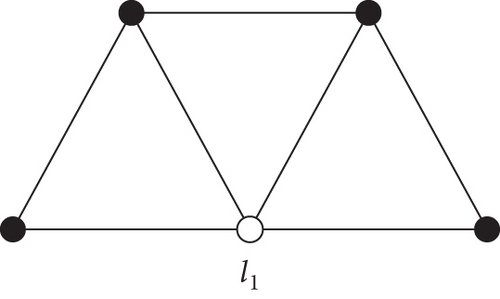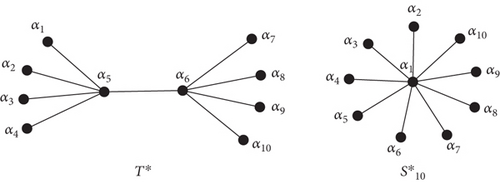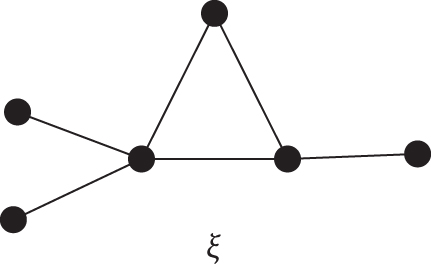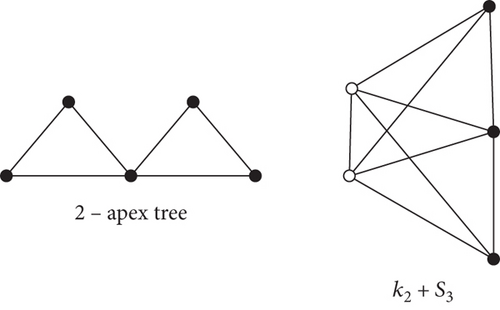[Retracted] On Second Gourava Invariant for q-Apex Trees
Abstract
Let G be a simple connected graph. The second Gourava index of graph G is defined as GO2(G) = ∑θϑ∈E(G)(d(θ) + d(ϑ))d(θ)d(ϑ) where d(θ) denotes the degree of vertex θ. If removal of a vertex of G forms a tree, then G is called an apex tree. Let L ⊂ V(G) with ∣L | = q. If removal of L from V(G) forms a tree and any other subset of V(G) whose cardinality is less than ∣L∣ does not form a tree, then G is known as q-apex tree. In this paper, we have calculated upper bound for 2nd Gourava index with respect to q-apex trees.
1. Introduction
A topological index is a numerical number associated with a molecular graph which has significant applications in chemical graph theory, because it is used as a molecular descriptor to investigate physical as well as chemical properties of chemical structure. Therefore, it is a powerful technique in avoiding high cost and long-term laboratory experiments. There are more than 3,000 topological invariants registered till now. Most of these indices have their applications in chemical graph theory. In these molecular descriptors, Gourava and hyper-Gourava invariants are used to find out the physical and chemical properties (such as entropy, acentric factor, and DHAVP) of octane isomers. The first and second Gourava invariants are highly correlated with entropy and acentric factors, respectively.
All graphs considered in our study are simple and connected. Let G be a simple graph with vertex set V and edge set E. For a graph G, the degree of a vertex θ is defined as the number of edges attached to it. The smallest degree of a vertex in G is denoted by δ(G). The vertex in a graph whose degree is one is known as pendent vertex. The neighborhood of a vertex θ is the set containing all nodes attached with θ, denoted by N(θ). There are two types of neighborhood, open neighborhood and closed neighborhood. If N(θ) includes all the other nodes except θ, then it is called open neighborhood but if it includes the node θ, then it is called closed neighborhood. Closed neighborhood of θ is defined as N[θ] = N(θ) ∪ θ. If we remove one vertex (say) θ from G, then the resulting graph is denoted by G − θ. If we remove subset (say) X′ ⊂ V of vertex set of graph G, then the obtained graph is denoted by G − X′. In molecular graph theory, an acyclic connected graph having order λ is known as tree and is denoted by . A tree with order λ is said to be star if central node has degree λ − 1 while all other nodes are pendent. In other way, a complete bipartite graph κ1,λ−1 is called a star of order λ. Let G1 and G2 be two vertex disjoint graphs then their join is denoted by G1 + G2 having vertex set as a union of their vertex sets, and the edge set contains all the edges of G1 and G2 and all those edges obtained by linking each node of G1 with each node of G2.
Ali et al. [5] investigated second and third modified Zagreb invariants for T-sum graph operation. Using the obtained results, they computed the second and third modified Zagreb of certain well-known chemical structures like alkanes. Cao et al. [6] give an exact formulas for the upper bounds of modified first Zagreb connection index and second Zagreb connection index for several binary graph operations like corona, Cartesian, and lexicographic product. Using the obtained closed formulas, they computed these invariants for several well-known graphs. In [7], the Gourava index for several graph operations is presented.
In molecular graph theory, apex graphs play a significant role, which can be elucidated as if removal of single vertex or subset of vertex set from a graph G yields a planar graph, then the graph G is known as apex graph [8]. Embedding of apex graphs having face width three are characterized in [9]. By using the same idea, one can explain the apex and q-apex trees. If we remove a vertex from G and the resulting graph is a tree, then that G is called an apex tree [10]. Similarly, if we remove a subset (say) X′ of vertex set of cardinality q from G and it results in a tree, then G is known as q-apex tree, provided that the removal of any other subset of vertex set whose cardinality is less than q does not form a tree [10]. A tree is known as trivial apex tree or 0-apex tree.
Therefore, a non-trivial apex tree is one which is not a tree itself but it can be converted into a tree by removing a single or number of vertices. In short, 1-apex tree is a graph which can be made a tree by removing single vertex as shown in Figure 1 (2-apex tree can be converted into a tree by removing 2 vertices as shown in Figure 2) and so on. In fact, apex trees are quasitrees which were introduced by Xu et al. [11]. Xu et al. [12] determined bounds on harary indices in case of apex trees. In 2018, Akhter et al. determined k-apex trees with extremal first reformulated Zagreb index [13].


2. Upper Bound of GO2 for q-Apex Trees
Let λ ≥ 3, q ≥ 1, and T∗(λ), and denotes the set of all no-trivial apex trees and q-apex trees on λ vertices, respectively.
Lemma 1. Let T∗ be a tree of order λ, and then
with equality holds if and only if T∗ = Sλ.
Proof. Since T∗ is a tree, it follows that for any edge θϑ ∈ E(T∗), we have N(θ)∩N(ϑ) = ∅. Hence, . Now, using the value of in the definition of second Gourava index, we get
Example 2. Let BS (a, b) be bistar graph obtained by joining the apex vertices of two star graph K1,a and K1,b on different vertices with a, b ≥ 1, and Sλ,a be the graph obtained by joining a − 1 pendent edges to the end vertex of path Pλ−a+1. Figure 3 depicts the graphs of BS(4, 4) and , respectively. By definition of second Gourava index, we have . In Table 1, we have computed the second Gourava index of some classes of trees on 8 vertices. Observe that has the maximum value among all other trees.
Lemma 3. Let u′, v′ ∈ V(G) be two nonadjacent vertices of G, and then
Proof. By definition of GO2(G), we have
Since d(u′), d(v′) > 0, it follows that GO2(G + u′v′) > GO2(G).
Lemma 4. Let G ∈ T∗(λ) with maximum GO2 value, and let x′ ∈ V(G) be an apex vertex, and then
Proof.
- (1)
Suppose δ(G) = 1 and y′ is a leaf node in G, then x′y′ is not an edge in G and G + x′y′ ∈ T∗(λ). Then, by Lemma 3, GO2(G + x′y′) > GO2(G) is a contradiction. Next, we prove that δ(G) > 2 is not possible. Suppose d(θ) ≥ 3 for all θ ∈ V(G), then for any θ ∈ V(G), the degree of all vertices in G − θ is greater or equal to two. This implies that G − θ is not a tree. Hence, δ(G) = 2.
- (2)
Suppose d(x′) < (λ − 1), then there exists a vertex y′ ∈ V(G) with x′y′ ∉ EG. Now, G + x′y′ ∈ T∗(λ) and GO2(G + x′y′) > GO2(G) are a contradiction. Hence, d(x′) = (λ − 1).
Lemma 5. Let G1 and G2 be two graphs on disjoint vertex sets with ∣V(G1) | = π1, ∣V(G2) | = π2, ∣E(G1) | = ϖ1, and |E(G2)| = ϖ2. Then,
Proof. By definition of second Gourava index,
Now, using the definition of joint of two graphs having disjoint vertex sets, we get
Let
Now, using the fact the value of A1 can be computed as
Similarly,
The value of C1 can be calculated as
Now, using the values of A1, B1, and C1 in Equation (2), we get
Theorem 6. Let G ∈ T∗(λ) and λ ≥ 5, and then
Proof. Let G ∈ T∗(λ) with maximum GO2 value. By Lemma 4, we have . Let the cardinality of vertex sets of κ1 and be ρ1 and ρ2 where cardinality of their edge sets is ς1 and ς2, respectively. Now by, using Lemma 1., we have
Example 7. Let G1 = κ1 + S6−1, as depicted in Figure 4 and G3 be 1 -apex tree of order 6 as shown in Figure 5. Then, the values of second Gourava index of these 1-apex trees are GO2(G1) = 810, GO2(G1) = 720, and GO2(G1) = 214. Table 2 depicts the values second Gourava index of some graphs in the class of 1-apex trees of order 8. Observe that GO2 of κ1 + S7 is maximum among all other graphs.
Theorem 8. Let q ≥ 2, λ ≥ 5, and , and then
Proof. We prove it by induction the value of q. For q = 1, the result follows from Theorem 6. Suppose the result is true for q − 1 apex trees, let with maximum GO2 and Vq ⊂ V(G) be the set of q-apex vertices. Since GO2(G + u′v′) > GO2(G) for any nonadjacent edges u′, v′ ∈ V(G), it follows that Vq is a clique in G. Hence, d(u′) = λ − 1 for all u′ ∈ Vq, and the number of edges m′ of the graph G is
Let x′ be an apex vertex and Vq−1 = Vq − x′. Observe that d(x′) = λ − 1 and G − x′ are an (q − 1)-apex tree. Then,
Hence, we get
Since GO2(G − x′) = (q2 − q)(λ − 1)3 + (λ − q − 1)(λ + q − 2)(q2λ − 2q) and for q ≥ 2,λ ≥ 5, we have
Using all the values in the above equation, we get
After simplification, we have
Example 9. Let G1 and G2 = κ2 + S5−2 be 2 -apex trees of order 5 as shown in Figure 6. Then, GO2(G1) = 224 and GO2(G2) = 888. Table 3 depicts the values of some 2 apex trees on 9 vertices. Observe that GO2 value of κ2 + S7 is the maximum among all others.

| T∗ | GO2(T∗) |
|---|---|
| S8 | 392 |
| BS (5, 1) | 312 |
| BS (4, 2) | 264 |
| BS (3, 3) | 248 |
| S8,5 | 212 |
| S8,4 | 146 |
| S8,3 | 108 |


| κ1 + S7 | 2198 |
| κ1 + BS(4, 1) | 1962 |
| κ1 + S7,4 | 1758 |
| κ1 + S7,3 | 1634 |
| κ1 + BS(3, 2) | 1277 |

| κ2 + S7 | 7824 |
| κ2 + BS(4, 1) | 7344 |
| κ2 + S7,4 | 7108 |
| κ2 + S7,3 | 6712 |
| κ2 + BS(3, 2) | 6684 |
3. Conclusion
In our present discussion, we have determined the maximum value of second Gourava invariant for q-apex trees. In future, it would be interesting to find the same results for those chemical invariants which are not investigated till now.
Conflicts of Interest
The authors declare that they have no conflicts of interest.
Acknowledgments
This work was supported by the National Natural Science Foundation of China (No. 62172116) and the Guangzhou Academician and Expert Workstation (No. 20200115-9).
Open Research
Data Availability
No data is required to support the study.




